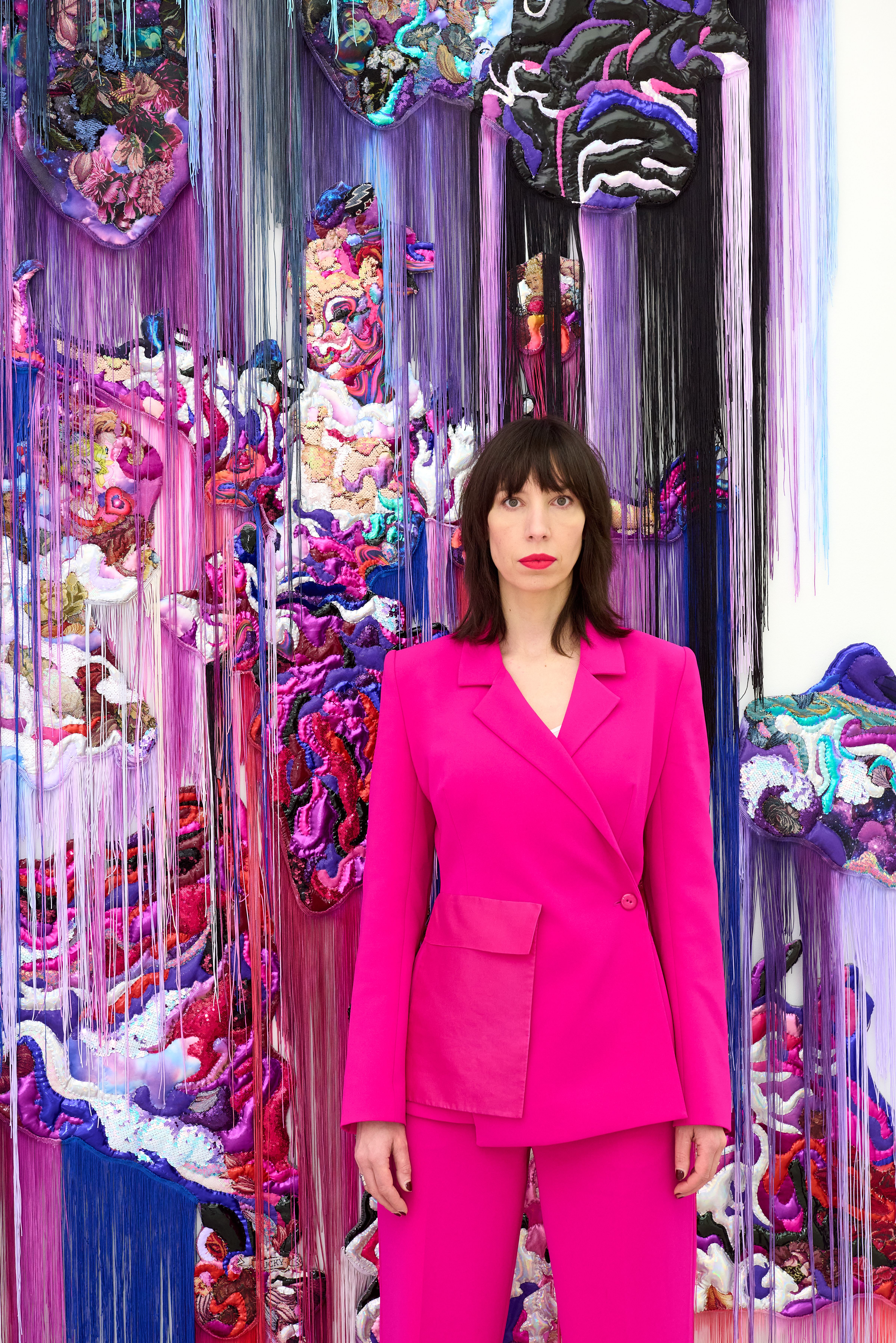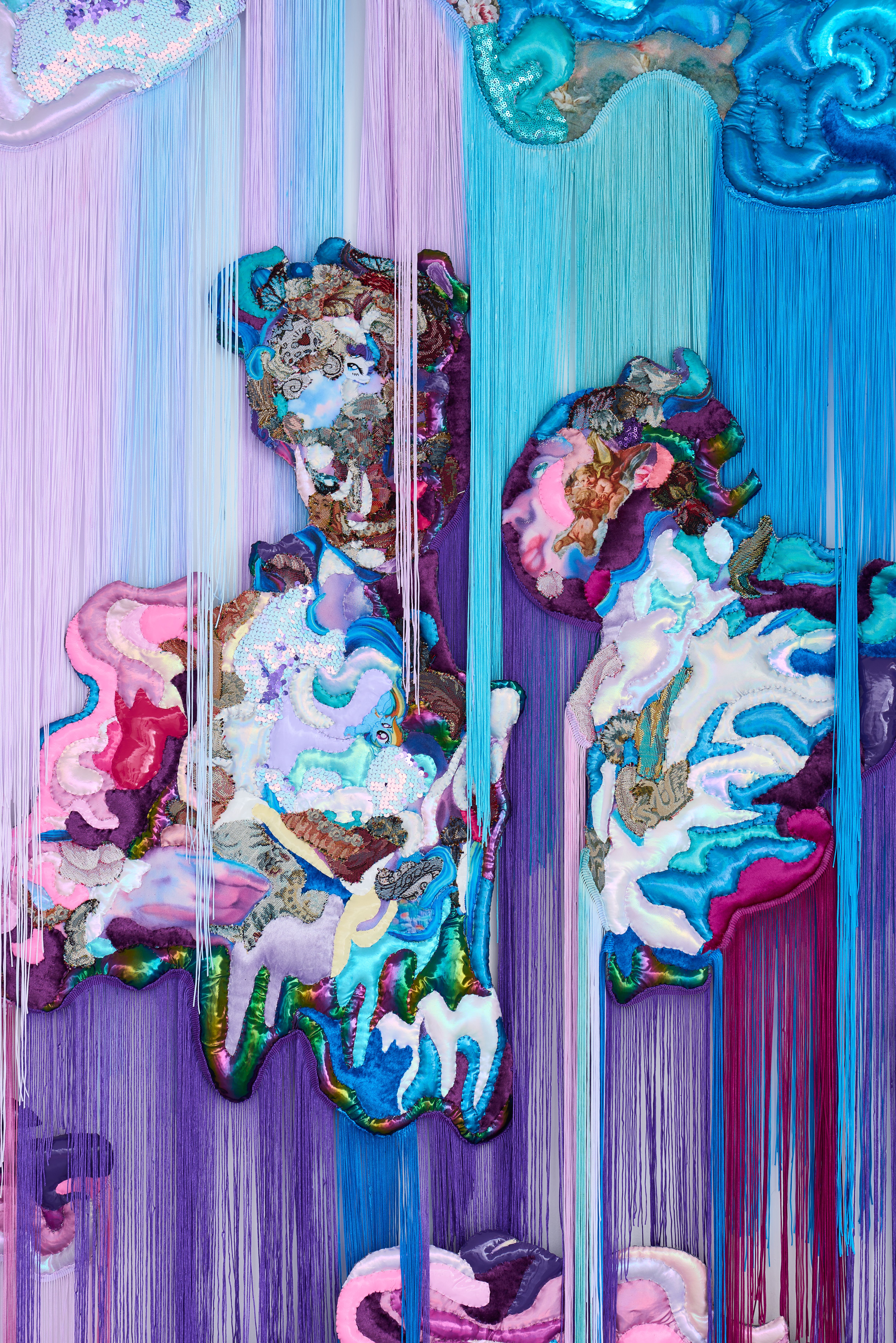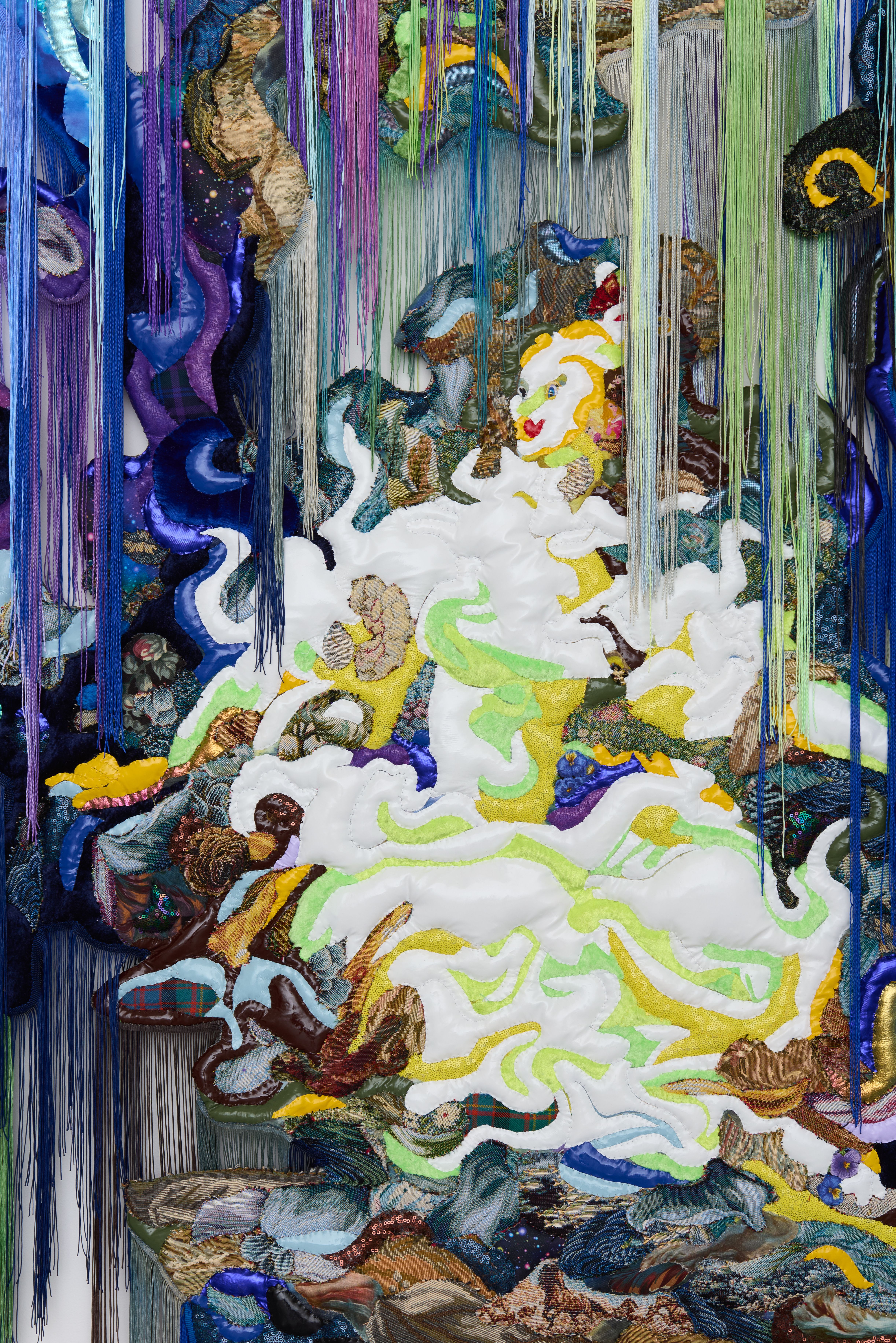
The London-based Dutch artist Anne von Freyburg brilliantly explores the interplay between textiles and decoration within the context of painting, critiquing traditional ideas surrounding the female gaze and femininity, while powerfully forwarding aesthetics all-too-often dismissed as secondary – challenging long-standing hierarchies in which crafts and decoration have been radically undervalued. The increasingly celebrated artist is about to make her US debut with the show 'Amour Toujours' at K contemporary Denver, exhibiting an extended version of her reinterpretation of five of Jean-Honoré Fragonard’s extended series of Rococo paintings collectively entitled The Progress of Love. In her woven re-imagining of these works, von Freyburg utilises the love story depicted in the paintings to reflect on saccharine clichés of romantic love. These bold, colourful expressions reassert domains traditionally tied to the feminine sphere and usurp tropes of art history, inviting contemplation on themes like taste, the boundaries between high and low art, and the social construction of female identity. As such, her visually compelling abstraction celebrates the sensuality, texture, and visual complexity of materials and ornamentation, while provoking thought on issues such as gender, overconsumption and self-indulgence in today’s culture. Here, the artist discusses her singular mission to reframe femininity, and tells us why great art must always seek to communicate honesty.
What would you say drives you creatively? How would you describe yourself as an artist?
What interests me is where the hierarchy between fine art and craft comes from and why ornamentation and detail was seen as something inferior to modernism. One could see the banning of ornament and decoration in art and society as a patriarchal strategy to diminish femininity. While I was exploring the history of ornamentation and decoration I couldn’t miss the direct link it has with textiles. There has always existed a hierarchy between painting and tapestry. One can still see that in how tapestries are categorised as craft and design in museum collections. Tapestry has been seen as reproducible low art, made by women, while male painting was seen as significant and important. Painting still has the highest value on the art market. The marginalisation of textiles and everything that’s linked with the feminine is what drove me in blending these two disciplines. Choosing the Rococo, an era that’s been categorised as frivolous and unserious, adds another layer of meaning to the work. I would say I’m a painter that uses fabrics as a medium to make extended hybrid works that sit between sculpture and painting.

Describe the ways in your work challenges and conversely celebrates notions of the feminine, and tell us why that is important to you…
In my practice I’m exploring the self through figurative and abstract painting, tapestry, textiles, craft and ornament. By making work that is overly feminine I’d like to open up the discussion around the construction of femininity, feminine heritage of ornaments and decoration. I would like to honour the feminine history of textiles and craft, because I think it is important to retain and reclaim its history and bring back the “feminine” decorative ornament in relation to abstract painting. To celebrate the feminine or what has been described and constructed as a feminine aesthetic is a way to reclaim it. That way it can be deconstructed and recreated, free from preconceptions. I want to celebrate sensuality, pleasure, joy, fierceness and intuition. Art should not only be viewed through the mind and consumed by the eyes but should also give space for the senses of touch and evoke pleasure and joy.
Your work has often been described as a comment upon consumerism, can you unpack your thoughts about the capitalist consumer construct and how your work tackles notions of excess?
In my opinion female identity nowadays is created through the female gaze on social media platforms. We are overwhelmed by mass media that confronts us with ever changing beauty standards. Additionally we see that on social media women are capitalising on themselves and making lots of money. The objectification of ourselves has evolved, validation now is often achieved through material means such as through fashion and plastic surgery. Still consumers, especially women, are kept insecure about their bodies and their looks through advertising, which makes people keep on buying. I think this is all very complicated and concerning and I don’t think my work is going to change this, but as it is part of my reality as well I feel the need to react on and make work about it. By disrupting the image through the swirls, drips and overload of materials and visual information I want to subvert the clichés of gender and beauty and turn it on its head, like looking into a distorted mirror at a fun fair. My work is questioning when material pleasure turns into excess. On the other hand women are often being criticised and discriminated for being to much and to loud. In that sense the work with all its vibrant colour and tacky materials is me being unapologetic about standing out and being loud.

Do you think the gender landscape of the art world is more equal than it used to be?
There are more women at top positions in the art world than ever before, which has a huge impact, but who get’s shown and pushed all comes down to their agendas and ideas and is not so much about their gender. In my view there are still double standards for women in the art world and world at large. I think it will take a long time before all the bias around women is gone. We see more women artists, yes, but as our identity is so intertwined with the artwork, I wonder sometimes if work is chosen because someone hit the right boxes, or for the quality of the work. Only the future will show us what survived. Whether it’s harder to break through as female artist, I can’t say. I decided to focus on the possibilities and not the disadvantages. I focus on seeing where my work and concepts connect with people.
Please describe your process and a typical day in the studio. How do you see an idea through from conception to completion?
My studio is in South London and commuting from where I live takes more or less an hour. In the early morning, I mostly do admin, like writing emails or write interviews. Since sewing takes up most of my time, which I can do from home on an embroidery frame, I spend 60 per-cent of the time at home, and the other time I work in the studio painting and collaging fabrics onto the painted canvas. When I arrive in the studio I immediately start working/collaging the fabrics on my painted canvas. If it’s a new painting, then I first gather all the fabrics that I need for that particular piece, which is mostly picked by colour, texture and print subject. The process of collaging is very intuitive and organic. I pick and choose, pin a piece and maybe later I see a better piece of cloth and replace it. It is really just try and error. Interpreting painting into fabrics is the part of the process that is most creative and which I love doing the most.

What is the conceptual core of your latest series of works?
I approached this new body of work as a declaration of the love and care
necessary for all of us to thrive. It gives us permission to do the things we love doing. It’s about being free and choosing your own path to happiness in relationships. No more fairy tales about men saving women; instead, it’s about women being the heroines in their own life stories. I hope the work brings joy and a feeling of empowerment to be your own weird self. While making I do think of the viewer and I hope they’ll engage long enough with the work to see my little jokes and hidden nuggets. Even though the reasons and topics behind my work are serious I try not to take the work and art too seriously. I find it important that the work can be enjoyed and be engaging for anyone and everyone. In general, I like art that is open and inviting – that it doesn’t ask to much time of a person, and gives space for interpretation. One has to think about the audience in my opinion, but not sensor the message. Art should stay honest.
How do you approach the colour spectrum and how much does the disruption of beauty inform your work?
Beauty is as much a construct as femininity is. Beauty is made and decided by who’s in power. Also historically beauty has been associated as male and something that only a men can create and judge over, women can only make pretty things. In my work I play with those ideas and turn the pretty in large-scale masculine size works and use beauty more as a double-edged sword to destabilise rigid conventions and restrictive behavioural models. By making work that challenges western ideas of beauty I’m indirectly disturbing identity, systems and order. Like ornament, colour has been seen as a cosmetic extra, feminine, artificial, dishonest and there to conceal. Colour is associated with irregularity or excess and therefor can promise liberty and threatens to disorder. Colour is also connected with our childhood - think of cartoons. Colour is connected with the unconscious - it doesn’t need words. When I use colour I think of the body. I think of colour as a way to resist order and normality. I use colourful fabrics rather than paint as they have more intensity and as my work talks indirectly about the body, it makes more sense to use fabrics as my colour palette than actual paint.

How has your art practice helped you evolve as a human being?
My practice helps me to grow as a person. It’s where I can be myself and also where I have to leave some perfectionistic tendencies at the door. I have to step in the unknown and allow myself to make something ugly, ridiculous and over the top. Making the work is more about challenging myself and allowing myself to go bonkers. When I read and write about the topics that interest me is when I learn about the world and my role in it. I do believe that reading, writing and self-development are equally important as making work. They feed of each other.
Anne von Freyburg exhibits at K contemporary in Denver Colorado on November 8. Find out more about the artist here and follow her on Instagram @annevonfreyburg
Images (from top to bottom): Portrait by Pasquale Viglione. Detail shot of 'Something in the Air has Changed (After Fragonard, the Progress of Love: the Meeting)2025; Electric Feel (After Fragonard, The Pursuit), 2025; Floral Arrangement 1 (After Jan van Huysum, Still-life), 2024; Detail shot of Tuttifrutti (After Jan van Huysum, Flower still-life), 2024. All photography Pasquale Viglione. All images courtesy of the artist.